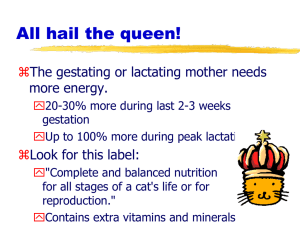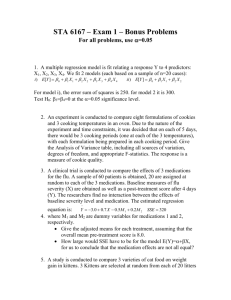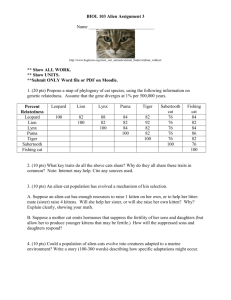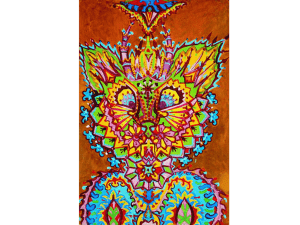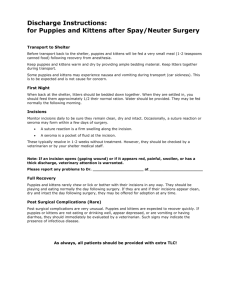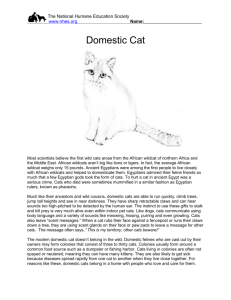HERE - AniMeals
advertisement
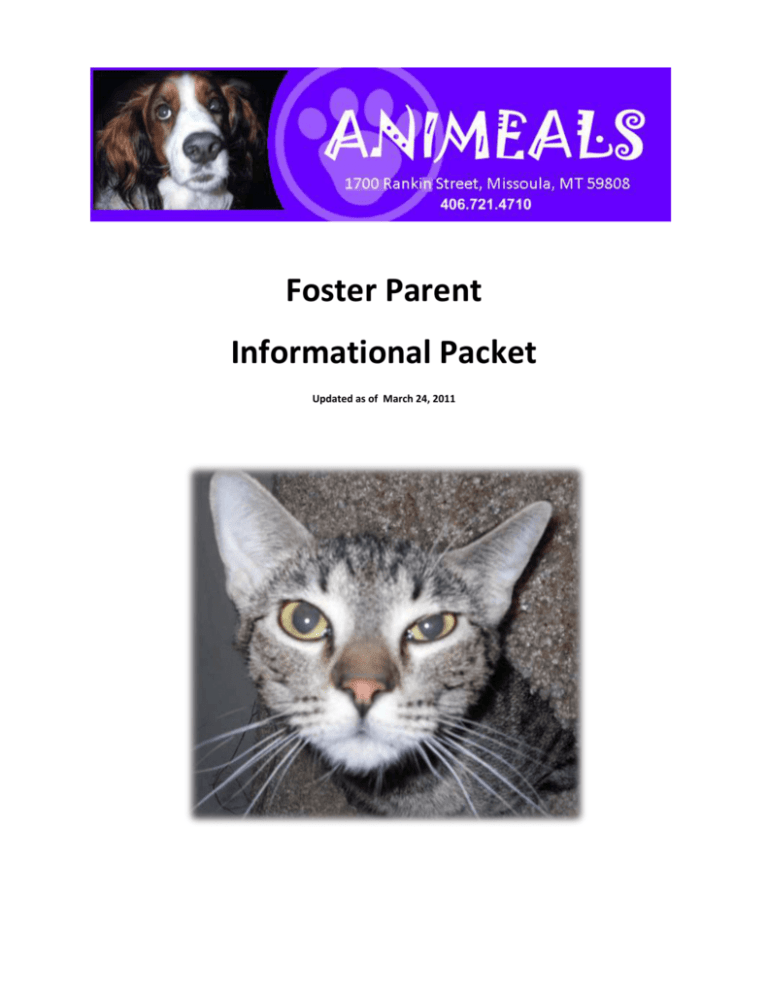
Foster Parent Informational Packet Updated as of March 24, 2011 A Comfortable Home for Your Animal Choose a warm, well-ventilated, quiet area that is out of the main flow of traffic. Provide cat with its own cat box, bed, food and water. The floors should be easy to clean (tile or linoleum is good with lots of blankets completely covering floor for warmth). Nursing animals should have blankets to nest in. Please clean the area at least once a day with 409 or Bleach. This is to help keep healthy babies. (Bacteria can cause problems for the babies.) Food and water bowls should be cleaned daily. There should be water available at ALL TIMES. All cats must have clean litter pans, so scoop them daily. Nursing animals should have blankets to nest in. Your privately owned animals must be kept away from the Foster Animals. This action will help ensure that your own animals remain free of any sickness, and will also avoid problems such as jealousy. Spend time with the animal separate from your own for helping maintain/socialization with humans. General Problems/Concerns If you have any questions regarding the care of your Foster Animal, please call the Shelter Tuesday to Friday 8:00 AM to 5:00 PM, Saturday 11:00 AM to 4:00 PM – Phone # 7214710. * After Hours: Call Steph – 207-7573 – leave a voice mail or feel free to text. If the animal is sick and needs to be examined, call during Shelter hours, talk with shelter staff and then bring the animal to the Shelter if required. If an emergency happens outside the Shelter hours, you may take the foster animal to your veterinarian or an emergency service at your own cost. Please notify AniMeals the next day. If an animal dies at home, please notify us during phone hours (as above). All deceased animals should be brought into the Shelter. Your animal should be checked soon if you notice these general signs: Appetite is greatly decreased Diarrhea (collect sample & refrigerate) Discharge from eyes or nose Coughing a lot Sneezing Pain or lameness Skin rash or bald area Refusing food for more than 24 hours Vomiting repeatedly Call Us Immediately If You See Any Of These Symptoms: Eyes Yellow or green discharge Uneven pupil dilation, seek immediate attention Swollen conjunctiva, including 3rd eyelid White film or cloudiness over eye Yellowing on white part of eyes Ears Dark, flaky debris, especially in cats Dark, waxy discharge accompanied by yeasty smell Yeasty smell with no discharge Painful when rubbed or cleaned Frequent scratching at ear Nose Yellow or green discharge Scabs or skin loss Bleeding from nose Excessive sneezing, especially in cats Nose can be wet or dry. This is not necessarily an indication of illness. Mouth Loss of appetite – in adults for more than a few days, in juvenile animals for more than one day. Increased appetite for over a week Vomiting, usually more than three times. If vomit is bloody or dark, seek immediate attention. Please keep a sample in a ziplock bag and bring it to AniMeals. Coughing and/or gagging, accompanied by phlegm. Coughing after pressure is placed on trachea by collar. Trouble eating or chewing, painful gums or teeth Pale gums Ulcers or lacerations on gums or lips Excessive salivation, especially a change in the amount of salivation Enlarged lymph nodes Neck Front legs Rear legs Gait Sudden lameness that does not improve within a day Animal exhibits pain upon walking or handling Temperature Animals with rectal temperature below 99.5 or higher than 102.5 at rest (outside the normal range). Animals that are playing have a higher temperature. Skin Lacerations Lumps Hair loss Scabs Animal that has frequent scratching or, itchiness or if you have bites after holding a foster animal Anal/Genital Area Diarrhea, especially bloody liquid diarrhea, seek immediate attention. Keep a sample in a ziplock bag and bring into AniMeals. No bowel movement for more than 48 hours. No urination for more than 24 hours, especially in male cats. Behavior Lethargic Poor appetite Increased appetite with weight loss Excessive drinking Increased urination or accidents in the house Straining to urinate or defecate Frequent scratching at ears or skin Seizure or convulsions, seek immediate attention If you are uncertain about any aspect of your foster animal’s health… CALL US!!! (There are no stupid questions!) 721-4710 Steph after hours: 207-7573 First Aid Kit Checklist ____ Alcohol ____ Saline Solution ____ Nose Drops “Little Noses” (for sneezing and runny nose) ____ Neosporin ____ KY Jelly or Lubricant ____ Thermometer (room) ____ Thermometer ____ Gauze Pads ____ Small Cloths (Baby Wipes) ____ Cotton Tape ____ Tweezers ____ Nail Clippers ____ Flea Comb ____ Small Brush ____ Baby Bottles (2) ____ Small Syringes ____ Large Syringes ____ Gloves ____ Stuffed Toys to Cuddle Up to ____ Feline Milk (Kitten Milk Replacement) General Vaccine Schedule FVRCP (Feline Viral Rhinotracheitis, Calici and Panleukopenia): First Vaccine: 9 weeks of age Booster: 3-4 weeks after first vaccine Second Booster: 3-4 weeks after booster Annual Booster RABIES: First Vaccine: 6 months of age Booster: Annually Worming: Every 3 weeks at 4 weeks of age continuing until out of shelter. Fostering Injured or Surgery Recovery Animals The shelter receives animals in need of extensive medical treatment. Injuries resulting from being hit by a car, attacked by another animal, abuse, neglect or accidents. The foster care period for an animal recovering from surgery may vary from a few days to months, depending on the severity of the injuries and treatment involved. These animals may require daily medications or special diets, as well as regular veterinary check-up visits. Many animals need complete ‘bed rest’ in order to fully heal, and others will require some sort of rehabilitation exercise. Facilities needed: Depending on the mobility of the animals, an easily accessed, easy-to-clean area, separated from your own companion animals, is ideal. Depending on the recovery needs of the animals, they may need a quiet place to stay. For others, being right in the middle of things is best. It is important for injured animals to be supervised when outdoors and when interacting with other animals. Cats must be kept “indoors only” during the foster stay and in carriers while traveling. Suggested supplies: Medications and special equipment will be provided by the shelter. Crate/kennel/carriers Old blankets, bedding materials/towels Stain/odor remover Litter pan, kitty litter and scoop Toys Food: Growth formula if animal is younger than a year or is a nursing mother. Daily duties: Administer medications/ointments as required Exercise animals as required for therapy Provide “bed” rest conditions, if required Report any health or behavioral problems to Foster Care staff Feed, supply fresh water Clean bowls, bedding if needed Clean area where animal urinates and defecates; check for any problems (blood in urine, runny stools) Groom coat Check fur Examine paws Check ears and eyes Look inside mouth at gums and teeth Play with and socialize animal As needed duties: Ensure animals make weekly check-up appointments Check your food and litter supplies – always keep a supply of food on hand so that you’ll never run out. Clean bedding Trim nails – help to prevent declawing in the future Fostering Under-Socialized Animals Under-socialized, neglected, and frightened shelter animals may be the most challenging to foster as they require specialized care (and sometimes training) in order to qualify for our adoption program. Requiring a lot of patience and time of their foster parent, these animals may have never been inside a house or car, may not be housetrained, and may have never before experienced kindness from a human. Under-socialized animals must be closely monitored to reduce the chance of escape or destructive behavior. They frequently require fostering for at least a month while they acquire the social skills that will make them treasured lifelong companions for a lucky family. Facilities needed: An easy-to-clean area separated from your own companion animals, yet not isolated from normal activities is ideal. Crating dogs can be extremely helpful to both foster parents and potential adopters, so a place for an appropriate size crate is desirable. Feral (or unsocialized) cats are housed best in smaller sized rooms with just a few hiding places (bathrooms are ideal) where they can be easily found. Cats must be kept “indoors only” during their foster stay and in carriers while traveling. Suggested supplies: The shelter will provide a collar and ID tag for cats. Crate/kennel/carriers Old blankets/towels Ceramic/weighted bowls Toys Brushes/nail clippers Kitty litter Scratching post Food: High quality formula, dry and/or canned Growth formula if animal is younger than a year or a nursing mother. Daily duties: Handle the animal; talking, stroking, brushing, lifting paws, checking ears, mouth, eyes General Information for the Care of Foster Kittens A lactating mother cat should be fed a kitten diet. The kittens should be checked several times a day to be sure that they are all nursing. They should be warm and have pink noses and tongues. Their bellies should be slightly rounded. Kittens should be just eating and sleeping during the first few weeks of life. IF the kittens are crying they are probably hungry or cold. The kittens’ eyes should be open at about 10-14 days of age. If the kittens do not have a mother, they should be kept in a room with a temperature of at least 75 degrees Fahrenheit. They must have a clean litter pan at all times and fresh water must be available. These kittens can be kept clean by sponge bathing. Use a PowerAde or Gatorade bottle filled with hot water to serve as a pseudo mother. The kittens will curl up around the warm bottle. Wrap in towel so kittens will not burn themselves. Feed kittens that are 4 weeks of age a mixture of kitten food and water. Add just enough water to make the food mushy. Feed fresh food 3-4 times a day leaving the food with the kittens for about ½ - 1 hour. The mother will usually begin to wean the kittens when they reach 6-8 weeks of age. If the mother seems reluctant to wean her kittens, you can separate the mother from the kittens for several hours a few times a day for a few days to ensure that the kittens are eating on their own. Be sure that all the kittens are eating. Kittens must eat EVERY day. If one kitten is not eating, separate it and observe it closely. If the kitten is not eating for 24 hours, it must be checked by a shelter employee. An excellent method of determining if kittens are eating well is to weigh the kittens every couple of days. A small kitchen scale works well or they may be brought into the Shelter regularly, especially if there are ANY concerns. Kittens should be gently handled a few times a day. Pick them up, stroke them, and touch their feet, ears and tail. Talk to them while they are being handled, which helps socialize them with trusting humans. Fostering Newborn Kittens (“Baby Kittys”) We often receive nursing cats with their young, or orphaned kittens. Foster homes are needed to provide nursing mothers a safe, warm environment in which they can raise their young. In this type of situation, foster volunteers closely monitor the progress of the litter, providing attention and socialization to the adult animal and the growing kittens. When young animals are abandoned, foster volunteers are needed to bottle feed them and provide them with round-the-clock care. Along with feeding, foster parents must stimulate young animals to eliminate, take care of their grooming requirements, and monitor their progress closely. The first few weeks of a young animal’s life can be intense as these young animals are more prone to health and digestive problems. The results are rewarding as you watch your “baby kittys” grow into healthy kittens. The length of foster care for “baby kittys” is typically 2 months and animals are placed into foster care with their litter or individually. Facilities needed: Newborn animals are easily kept in small carriers, baskets, and boxes. As they grow, an easy-to-clean area separated from your own companion animals, yet not isolated from normal activities is ideal. Kittens need to be kept “inside only” throughout their foster period and in carriers when traveling to and from the shelter or Veterinary Clinic. Suggested supplies for newborns: Animal nursing bottle with nipple or syringe with or without nipple Tissues, toilet paper, baby wipes, cotton balls Stuffed toys to cuddle with Food: Feline milk replacement will be provided by the shelter - Never feed cow’s milk to your kitten. - Shelter will provide special diet if needed. Nursing mothers will need high quality food, usually the kitten growth formulas work best for them – they will need a lot of it too! As needed duties: Help nursing mothers when they are ready to wean infants. Check food, milk supplies Clean bedding Daily duties: Feed nursing mothers and observe their overall health and behavior Supply fresh water to nursing mothers Feed orphaned kittens as often as every 2-3 hours throughout the day and night, supplement with formula any kitten with nursing mothers, if needed Stimulate orphaned babies to urinate and defecate after every feeding Clean orphaned kittens after feedings While handling kittens, look for signs of development (eyes open, ear flaps unfolding, teeth erupting) Examine ears, eyes, noses, mouth, paws, tails, body Clean nursing bottles, syringes and nipples Fostering Juvenile Kittens One of our common needs for foster care is for animals that are too young to be placed into the adoption center. Kittens must be at least eight weeks of age and weigh 2 lbs 2 oz. to be eligible for placement. In the spring and summer months, we receive many animals younger than 8 weeks of age and placement in a foster home allows these animals to mature, to become socialized, and to begin their vaccination series. In many cases, young kittens are spayed or neutered while in foster care and recover from the procedure for a few days before being returned to the shelter and placed up for adoption. Young animals are usually placed in to foster care with their littermates, but occasionally we will separate the litter or have a single orphan animal that needs care. Facilities needed: An easy-to-clean are separated from your own companion animals, yet not isolated from normal activities will be ideal. Examples are a bathroom, spare bedroom, heated laundry room, or kitchen. Kittens must be kept “indoors only” throughout their foster period and in carriers when traveling to and from the shelter or Veterinary Clinic. Suggested supplies: Cotton balls Old blankets/towels Newspaper Ceramic/weighted bowls Stain/odor remover Toys Brushes/nail clippers Heating pad Notebook Carrier Uncovered Litter box (smaller size) Non-clumping litter Scoop Scratching Post Daily duties: Feed (may be necessary 2 to 4 times a day) Clean bowls Supply fresh water Introduce to litter box Socialize animal, when ready, to other people Clean area where animal urinates and defecates, check for any problems (blood in urine, runny stools) Clean bedding as needed As needed duties: Notify Foster Care staff with problems, either with health or behavior Attend weekly or bi-weekly behavior/health rechecks Fostering Sick Animals Shelter animals are frequently exposed to diseases that can be contagious to other animals. These illnesses can affect animals of all ages and can include upper respiratory infection in cats, dermatological (skin) issues, and intestinal parasites. Due to these illnesses, the immune system of the infected animal may be compromised and it is important to place that animal in a secure, safe environment during recovery. While fostering ill animals, it is likely that a volunteer will administer daily medication, provide a special diet, and ensure that the animals are taken to weekly veterinary check-ups. Facilities needed: An easy-to-clean area that is completely isolated from your own companion animals, such as a spare bathroom, bedroom, den, and heated basement. Cats must be “indoors only” throughout the foster period and in carriers when traveling to and from the shelter. Suggested supplies: Medications will be provided by the shelter. Pill applicator Towels/blankets Stain/odor removers Ceramic/weighted bowls Toys Brushes/nail clippers Crate/kennel/carrier Litter pan and kitty litter Scratching post Food: The shelter will provide special diets (high protein, low carb) if needed. Daily duties: Medicate as directed by veterinarians Observe for signs of improvement/deterioration Inform Foster Care Department if problems occur Feed, supply fresh water Clean bowls, bedding, if needed Clean area where animal urinates and defecates; check for any problems (blood in urine, runny stools) Socialize, play with animal As needed duties: Ensure animals make weekly check-up appointments Check food, litter supplies Trim nails Developmental Stages of Kitten Behavior Well-socialized cats are more likely to have well-socialized kittens. Kittens “feed” off of their mothers’ calm or fearful attitude toward people. Although feeding time is important, it’s also vital to include petting, talking and playing in order to build good “people-skills” in your kitten. Kittens are usually weaned at six or seven weeks, but may continue to suckle for comfort as their mother gradually leaves them more and more. Orphaned kittens or those weaned too soon, are more likely to exhibit inappropriate suckling behaviors later in life. Ideally, kittens should stay with their littermates (or other role-model cats) for at least 12 weeks. (Typically 5 7 per foster home, or more if possible) Kittens orphaned or separated from their mothers and/or littermates too early often fail to develop appropriate “social skills,” such as learning how to send and receive signals, what an “inhibited bite” means, how far to go in play-wrestling and so forth. Play is important for kittens because it increases their physical coordination, social skills and learning limits. By interacting with their mother and littermates kittens learn “how to be a cat,” as well as explore the ranking process (“who’s in charge”). Kittens that are handled 15 to 40 minutes a day during the first seven weeks are more likely to develop larger brains. They’re more exploratory, more playful and are better learners. Skills not acquired during the first eight weeks may be lost forever. While these stages are important and fairly consistent, a cat’s mind remains receptive to new experiences and lessons well beyond kitten-hood. Most cats are still kittens, in mind and body, through the first two years. The following chart provides general guidelines for the stages of development. NEWBORN 0-2 WEEKS (NEONATAL) Learning to orient toward sound. Eyes are opening, usually open by two weeks. Competition for rank and territory begins. Separation from their mother and littermates at this point can lead to poor learning skills and aggression toward people and other pets, including other cats. Newborn-7 days - Eyes and ears closed - Pigments on lips and paws are red in color - Weighs about 3-4 ounces at birth and should double by first week - Have no gag-reflex at this age = force feeding can cause pneumonia. Warm kittens first and feed them no more than 1 cc of warm milk at a slow pace - Cannot retract their claws yet - Umbilical cord falls off around 3 days of life **Keep handling to a minimum! Feeding Bottle Babies (Newborn-7 days) Milk replacer is used to feed orphans 4 weeks or younger. NEVER use cow’s milk! Kittens in their first week of life should receive the following approximate amounts of formula every 24 hours: 3 ½ to 4 cc per ounce of body weight per day. Feed every 2-3 hours. This amount of formula should be fed in equal portions divided between the appropriate number of daily feedings. Hold the kitten to bottle feed in the same position they would be if they were nursing on their mother. Their feet should be on the floor or your lap. Don’t hold them on their backs—they can choke! 1-2 weeks Old - Weighs about 6-8 ounces at week 1 and gains about 4 ounces each week - Eyes open at 7-10 days and usually fully open by 2 weeks - Eye colors are blue/greenish in color - Very limited mobility - At the end of first week, shiver reflex develops Feeding Bottle Babies (1-2 weeks Old) Milk replacer is used to feed orphans 4 weeks or younger. NEVER use cow’s milk! Kittens in their second week of life should receive the following approximate amounts of formula every 24 hours: 5 cc per ounce of body weight per day. Feed every 4 hours. This amount of formula should be fed in equal portions divided between the appropriate number of daily feedings. Hold the kitten to bottle feed in the same position they would be if they were nursing on their mother. Their feet should be on the floor or your lap. Don’t hold them on their backs—the can choke! 2-7 WEEKS = SOCIALIZATION By the third week smell is well-developed and they can see well enough to find their mother. By the fourth week smell is fully mature and hearing is well-developed. They start to interact with their littermates, they can walk fairly well, and they’re teeth are erupting. By the fifth week sight is fully mature, they can right themselves, run, place their feet precisely, avoid obstacles, stalk and pounce, and catch “prey” with their eyes. Start to groom themselves and others. By the sixth and seventh weeks they begin to develop adult sleeping patterns, motor abilities and social interaction. 3 WEEKS Old - Weighs about 12 ounces - Begins to stand between 3-4 weeks but movements are wobbly - Ears fully erect - Baby teeth coming in - Heads look disproportionately large for bodies and legs - Can retract claws - Can start eliminating on their own Feeding Bottle Babies (3 weeks Old) Milk replacer is used to feed orphans 4 weeks or younger. NEVER use cow’s milk! Kittens in their third week of life should receive the following approximate amounts of formula every 24 hours: 5 ½ to 6 cc per ounce of body weight per day. Feed every 5 hours. This amount of formula should be fed in equal portions divided between the appropriate number of daily feedings. Hold the kitten to bottle feed in the same position they would be if they were nursing on their mother. Their feet should be on the floor or your lap. Don’t hold them on their backs—the can choke! 4-5 WEEKS Old Starting at 4 weeks, kittens should be introduced to safe toys. Try to give them a new toy every day (rotate the toys if necessary). Also, introduce them to new surfaces, smells, rooms, obstacles, sounds, people, etc. - Should weight between 16-20 ounces - Can walk around freely and start playing with siblings - Eye color starts to change to adult hue - Can be introduced to canned food - Start grooming themselves and littermates Feeding Bottle Babies (4-5 weeks Old) Milk replacer is used to feed orphans 4 weeks or younger. NEVER use cow’s milk! Kittens in their fourth week of life should receive the following approximate amounts of formula every 24 hours: 6 per ounce of body weight per day. Feed every 3 hours. This amount of formula should be fed in equal portions divided between the appropriate number of daily feedings. Hold the kitten to bottle feed in the same position they would be if they were nursing on their mother. Their feet should be on the floor or your lap. Don’t hold them on their backs—the can choke! 6-7 WEEKS Old - Approximate weight: 24 oz. at 6 weeks; 28 oz. at 7 weeks - Develops adult sleeping patterns, motor skills and social interaction - By 6th and 7th week, begins to eat solid food on own 8-14 WEEKS = MOST ACTIVE PLAY PERIOD Social and object play increases their physical coordination and social skills. Most learning is by observation, preferably from their mother. Social play includes belly-ups, hugging, ambushing and licking. Object play includes scooping, tossing, pawing, mouthing and holding. Social/object play includes tail chasing, pouncing, leaping and dancing. 8 weeks Old - Approximate weight: 32 oz. (2lbs) Once the kittens are 8 weeks of age, weighs at least 2 lbs and are healthy, they will be received and put on view for adoption….. …..SO, TAKE PICTURES FOR US!! - The best time for the kittens to go to a permanent home is between 10-12 weeks, so we LOVE to have pictures starting at 8 weeks so we can post them online and show off the kitties! Please take many beautiful pictures of the kittens you’re fostering and email them to Steph: warehouse@animeals.com 3-6 MONTHS = RANKING PERIOD Most influenced by their “litter” (playmates now include companions of other species). Beginning to see and use ranking (dominant and submissive) within the household, including humans. 6-18 MONTHS = ADOLESCENCE Heightened exploration of dominance, including challenging humans. If not spayed or neutered, beginnings of sexual behavior. Health Information **If you have any concerns, please contact the Shelter ASAP** All cats must have inoculations against 3 very dangerous diseases: 1. Panleukopenia: Panleukopenia, more commonly known as feline distemper, is a severe, highly contagious viral disease of cats and kittens. The panleukopenia virus invades cells which are rapidly growing such as those of the digestive system, bone marrow (which makes blood cells), lymph tissue, and developing nervous system. This explains the common symptoms of bloody diarrhea, vomiting, severe dehydration, anemia, seizures, and often death. 2. Rhinotracheitis: This is a serious viral infection that accounts for about 45 percent of respiratory diseases that affect the cat. Symptoms include sneezing, coughing, fever, redness and dripping of the eyes and nose, drooling, mouth breathing and loss of appetite. Ulcerations of the eye can also occur, especially in kittens. 3. Calicivirus: This disease accounts for another 45 percent of all respiratory diseases. Symptoms include fever, depression, sneezing, ocular discharge, trouble breathing, ulcers on the tongue and hard palate, and dehydration. EARS The most persistent and irritating ear problem of cats is ear mites. The mite’s entire life cycle is on the thinner surface of the ear tissue, depositing its eggs in the nooks and crannies. If your cat is shaking its head or pawing at its ears, take a good look inside. Mites are probably the answer if you notice a brown, black, or blood colored crusty and gray waxy material instead of a clean, pink surface. If a mite infestation is detected, notify the shelter. To avoid ear problems, Foster Volunteers should regularly examine their cat’s ears. A healthy ear is pink, free of scales or scabs, swellings or parasites. To clean a cat’s ears of wax or soil, gently wipe out the ear canal with a cotton ball. Never probe deeply into your cat’s ears. You can do more damage than good. Never go further with an object than your finger could, and be gentle. Infections of the ear flap are often caused by the cat scratching at fleas or ear mites and many cause abscesses. EYES Conjunctivitis (pink eye), inflammation of the mucous membrane covering the anterior portion of the eye, can occur, sometimes as a result of bacterial or viral infections. Constant discharge from the eye is a symptom of either a local infection or of systemic disease. Many ocular problems, especially mucous discharge, are signs of serious viral disease such as Chlamydia or Rhino Virus. Cats have a third eyelid (called a nictitating membrane) that is usually out of sight. Its function is to remove dust or other irritants from the eye, and possibly to protect the eye during hunting or other such dangerous pursuits like eyeballing the cat next door, who has dared to set food on home territory! SKIN There are several types of parasites that affect the skin of cats: Ringworm is not caused by a worm, but is a superficial fungus. It show up as one of several well marked areas of hair loss, scaling and irritation, especially on the legs and head. It doesn’t seem to cause itching but can spread to OTHER ANIMALS AND HUMANS. Care must be taken to protect other animals and people in the dog’s household. Fleas are blood-sucking parasites who prefer the cat or dog, but if hungry will attack any source of blood. They are dark and flat with strong hind legs used for jumping. Treatment involves treating the pet, house, and yard all at once! Worms If a kitten appears to be malnourished even though you know it has been eating well, has frequent loose stools, a lack-luster coat and a bloated stomach, the kitten may have worms. If the kitten has any of these symptoms, call a Foster Coordinator or the Clinic. A fresh stool sample may need to be brought in to test to see if the kitten has worms. Kittens may still have worms even if they have no apparent symptoms; consequently, we routinely deworm the puppies. Typical worms are Tapeworms (looks like rice in the stool), and Roundworms (looks like spaghetti in the stool). Other In case you are wondering about your cat’s whiskers during your grooming sessions, remember that they are meant to be viewed, not violated. They serve to help a cat in its sensory perceptions. DO NOT trim or clip them. Diarrhea is among the most common of all ailments affecting cats. Do not give cats milk. Milk can cause diarrhea in many cats. Other causes of diarrhea include nervousness, allergy to food, poisons, parasites, improper absorption of food or change in food, and disease. Fecal analysis may help to determine the cause of diarrhea. FELINE UPPER RESPIRATIORY DISEASE Upper Respiratory Disease (URD) is a highly contagious respiratory disease of domestic cats. It can be cause by several viruses and microorganisms which primarily affect the eyes, nose, and throat of affected cats. Transmission of the disease occurs through aerosol droplets formed from a sneeze or cough. Almost all cats will come in contact with at least some form of URD at some time in their lives and many will become infected with the disease. Once a cat has been infected with URD, it may become a carrier of the virus. When the animal is stressed, the disease may resurface-the cat will show symptoms and the disease will become transmissible again. It is believed that approximately 60-70 % of all cats are carriers of URD. Clinical signs will vary depending on the form of URD that the cat is infected with. Symptoms also vary from cat to cat. The most common symptoms are: Intermittent sneezing and /or sneezing attacks Fever which lasts 3-4 days (101-102 is normal temp.) Dry cough Lack of appetite Drooling Nasal discharge Watery eyes; eyelids may paste shut in kittens Congestion, open-mouth breathing and wheezing Sensitivity to light Being a virus, there is no magic drug to make it go away. Veterinarians may institute antibiotic therapy to keep the animal’s resistance to secondary infection up but it will not make the “cold” go away. CARE AND FEEDING OF CATS WITH UPPER RESPIRATORY DISEASE Please feed canned food in the morning and evening, with 500 mg Lysine. Break open the capsule and sprinkle and sprinkle it on the food. Ocean whitefish, and salmon= Stinkiest the best. 1x Daily. Best method is to push the pill quickly and firmly down the back/center of the cat’s throat and hold the cat’s mouth shut until he/ she swallows. It the cat resists, wrapping the cat up in a large towel will help in restraining that cat’s legs. (Liquid is good alternative) As long as the cat continues to eat and doesn’t vomit or have diarrhea, you’re on the right track. Please call the Shelter is you have ANY concerns. 721-4710, or Steph’s cell: 207-7573 Each day, check the cat’s face. Use the surface of a cotton ball or gauze to clean encrustations around the nose. Use a new, clean gauze to clean any weeping or mucous from the eyes (a new gauze for each eye). A secondary infection of the eyes may be present, for which we will dispense eye ointment. You will be shown how to give this if necessary. This is given morning and evening. At the height of the virus, the cat’s sinuses may become stuffed up so that he cannot smell. Putting the cat in a room with a vaporizer, or having the cat in a closed bathroom when a hot shower is running, may help. Being unable to smell and feeling miserable may cause a cat to stop eating. Continue to offer food- the smellier, the better. (Ocean Whitefish or Salmon). Also Beechnut Baby Food (only meat – turkey, chicken, beef) may work. Heating food to increase the odors may help and offering a yummy canned food often entice them. This is very important! If after 24 hours this has not worked, it is time to call us. FELINE PANLEUKOPIENA (DISTEMPER) This disease of cats comes on very suddenly and severely, without apparent warning. A kitten less than two months old will commonly die from it in 24 to 48 hours. The associated virus is thought to be spread by contact with urine, feces, saliva or vomit of an infected cat. Epidemics are prevalent. This is one major reason for separating your own animals form the Foster Animals, and cleaning everything well. After an incubation period of about 2-9 days, the first signs appear as a high fever, severe depression and severe dehydration. Most often, vomiting follows soon after. At first, the vomit appears as a clear fluid; later is it yellowish (tinged with bile). Typically, the cat will lie with its head hanging over the edge of its water dish, not moving except to lap water. Often it is not the virus itself that produces such severe symptoms, but a secondary infection. In many cases the immune system is severely depressed, which opens the door to the growth of bacteria or other viruses. FELINE DISTEMPER- PROCEDURES In cats and kittens, this is often a fatal disease. From the onset of symptoms, it is usually less than two days before death occurs. For this reason, distemper is not to be handled by the Foster Volunteer. What YOU can do is: Before-armed: linoleum or tile flooring can be mopped with bleach (1:32 dilution) and make the best areas for Foster Animals. Do not allow access to non-bleachable areas (carpets, beds, sofas, etc.) until at least 10-14 days after you have started fostering the animal. Practice good isolation techniques: o Your cats should have no contact with the Foster Animal o Keep separate food dishes and wash them separately (and well) o Scrub the litter pan (separate) with bleach o At the entrance to the foster room, keep a spray bottle with strong disinfectant or a bleach solution (1:32 dilution). Always spray your shoes as you leave. o In the room, wear an old shirt/smock/coverall and leave it in the room. Wash it with bleach. o After leaving the room, or any contact with the animals, wash your hands. Have any guests wash hands before and after they play with the Foster Animals. IF DISTEMPER OCCURS: If you notice any symptoms, bring the entire litter/group back THAT DAY to see the Shelter veterinarian. Clean all surfaces the cat(s) have been in contact with. Mop all smooth surfaces and scrub into all crevices with a 1:32 solution of bleach. Clean the entire room THOROUGHLY. Remember that the virus is present in all bodily fluids. If a kitten was sneezing or had diarrhea, this must also be removed with a bleach solution. Do not use the room for ANY cats for a full month after the ill cats have been removed. In a small household, it may not be possible to isolate enough to make cat fostering safe for the next month. Do not despair-check out all the other types of volunteering we have to offer!!!
